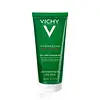What's inside
What's inside
 Key Ingredients
Key Ingredients

 Benefits
Benefits

 Concerns
Concerns

 Ingredients Side-by-side
Ingredients Side-by-side

Salicylic Acid 0.5%
MaskingWater
Skin ConditioningCoco-Betaine
CleansingPropanediol
SolventPEG-120 Methyl Glucose Dioleate
EmulsifyingSodium Chloride
MaskingSodium Cocoyl Glycinate
CleansingDipropylene Glycol
HumectantZinc Gluconate
Skin ConditioningBifida Ferment Lysate
Skin ConditioningSodium Hydroxide
BufferingSodium Benzoate
MaskingPhenoxyethanol
PreservativeCopper Gluconate
Skin ConditioningCaprylyl Glycol
EmollientTetrasodium Glutamate Diacetate
Parfum
MaskingSalicylic Acid 0.5%, Water, Coco-Betaine, Propanediol, PEG-120 Methyl Glucose Dioleate, Sodium Chloride, Sodium Cocoyl Glycinate, Dipropylene Glycol, Zinc Gluconate, Bifida Ferment Lysate, Sodium Hydroxide, Sodium Benzoate, Phenoxyethanol, Copper Gluconate, Caprylyl Glycol, Tetrasodium Glutamate Diacetate, Parfum
Water
Skin ConditioningKaolin
AbrasivePentylene Glycol
Skin ConditioningBentonite
AbsorbentPEG-40 Hydrogenated Castor Oil
EmulsifyingXanthan Gum
EmulsifyingGlyceryl Caprylate
EmollientNymphaea Caerulea Flower Water
Skin ConditioningPropylene Glycol
HumectantGuaiazulene
AntimicrobialGlycerin
HumectantBakuchiol
AntimicrobialCentella Asiatica Extract
CleansingPerilla Frutescens Leaf Extract
MaskingPunica Granatum Flower Extract
Skin ConditioningSodium Benzoate
MaskingSodium Salicylate
PreservativeTerminalia Ferdinandiana Fruit Extract
AntioxidantWater, Kaolin, Pentylene Glycol, Bentonite, PEG-40 Hydrogenated Castor Oil, Xanthan Gum, Glyceryl Caprylate, Nymphaea Caerulea Flower Water, Propylene Glycol, Guaiazulene, Glycerin, Bakuchiol, Centella Asiatica Extract, Perilla Frutescens Leaf Extract, Punica Granatum Flower Extract, Sodium Benzoate, Sodium Salicylate, Terminalia Ferdinandiana Fruit Extract
 Reviews
Reviews

Ingredients Explained
These ingredients are found in both products.
Ingredients higher up in an ingredient list are typically present in a larger amount.
Sodium Benzoate is a preservative. It's used in both cosmetic and food products to inhibit the growth of mold and bacteria. It is typically produced synthetically.
Both the US FDA and EU Health Committee have approved the use of sodium benzoate. In the US, levels of 0.1% (of the total product) are allowed.
Sodium benzoate works as a preservative by inhibiting the growth of bacteria inside of cells. It prevents the cell from fermenting a type of sugar using an enzyme called phosphofructokinase.
It is the salt of benzoic acid. Foods containing sodium benzoate include soda, salad dressings, condiments, fruit juices, wines, and snack foods.
Studies for using ascorbic acid and sodium benzoate in cosmetics are lacking, especially in skincare routines with multiple steps.
We always recommend speaking with a professional, such as a dermatologist, if you have any concerns.
Learn more about Sodium BenzoateWater. It's the most common cosmetic ingredient of all. You'll usually see it at the top of ingredient lists, meaning that it makes up the largest part of the product.
So why is it so popular? Water most often acts as a solvent - this means that it helps dissolve other ingredients into the formulation.
You'll also recognize water as that liquid we all need to stay alive. If you see this, drink a glass of water. Stay hydrated!
Learn more about Water